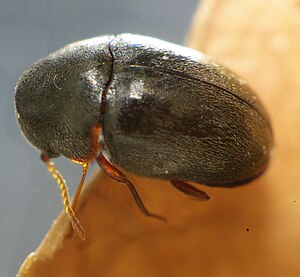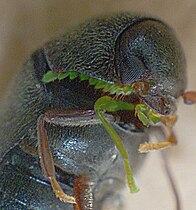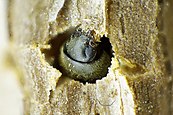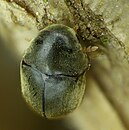Mesocoelopus niger
| Mesocoelopus niger | ||||||||||||
|---|---|---|---|---|---|---|---|---|---|---|---|---|

Mesocoelopus niger |
||||||||||||
| Systematics | ||||||||||||
|
||||||||||||
| Scientific name | ||||||||||||
| Mesocoelopus niger | ||||||||||||
| ( PWJ Müller , 1821) |
| Pictures of ball power | |
  
|

|
|
Fig. 9: Beetle from above, side and below |
Fig. 10: The body parts on one side that are completely drawn in are tinted green (feelers, buttons, front legs) |
Mesocoelopus niger is a beetle from the family of the furniture beetle . The genus Mesocoelopus is represented in Europe with six species . In Central Europe, Mesocoelopus niger is the only representative of the genus, which is mainly represented in Africa. According to its occurrence on ivy ( Hedera ), Laporte de Castelnau chosethe name Dorcatoma hederae for his description of the species in 1840, and Dufour described the species under the name Xyletinus hederae in 1843 . The ability of the rodent beetles to curl up like a ball isparticularly well developedin Mesocoelopus niger .
In the Red List of Endangered Animals, Plants and Fungi in Germany and in the Red List of Bavaria , the species is listed under Category 3 (endangered). In Schleswig-Holstein the species is classified as extremely rare (category R).
Notes on the name
It was first described in 1821 by the German theologian and entomologist Philipp Wilbrand Jacob Müller , who is often abbreviated as PWJ Muller in literature. He described the beetle under the name Ptilinus niger . The short Latin description begins with niger, .. ( Latin black, ..), which explains the species name niger through the black color of the beetle. In the corresponding publication, immediately after the description of Ptilinus niger, there is a description of another rodent beetle under the name Ptilinus hederae (today Ochina ptinoides ). This is confusing since various entomologists have used the specific epithet hederae for Mesocoelopus niger . The genus Mesocoelopus was established by Jaquelin du Val in 1860 as a split from the genus Xyletinus and Mesocoelopus niger was established as a type . The name Mesocōēlopus is derived from the three ancient Greek words μέσος (mésos for middle), κοίλος (kōīlos for belly) and πούς (pōūs for foot). The name alludes to the fact that the underside of the beetle has cavities to accommodate the legs.
Description of the beetle
When viewed from above, the body is briefly oval and at first glance appears to be evenly curved. It is black-brown to black. Lip and jaw palpations, tarsi, partly the splints and the antennae apart from the basal phalanx are yellowish. The top is very fine, not very deep and densely dotted . The puncture is easily overlooked because the beetle has delicate, short, silver-gray hairs that become more intense on the sides (Fig. 6). The very variable body length is between 1.8 and 4.2 millimeters, in older literature 1.8 to 2.1 millimeters is given.
The head, slightly arched, is large, lowered on the chest and drawn back to the eyes in the fore chest . The front-edged head shield is separated from the forehead by an indistinct transverse seam. At the front it is broadly concave (Fig. 5). The dark round oval eyes are flat and widely separated. They have a very weak indentation on the inside (Fig. 3). In addition, the eleven-part feelers (Fig. 7) are pivoted. They are slender and longer than the breastplate. The basal segment is irregularly elongated bulbous, the second segment is conical. The following eight links are somewhat crowded, from the fourth link onwards they are built roughly identically and drawn out into a triangle on the inside so that the feelers appear evenly serrated from the fourth link onwards. The end link is oval to elliptical. The upper jaws are split to two-toothed at the tip. The last link of the jaw palpation is longer than the previous one, elongated and truncated inward, but not ax-shaped. The end link of the lip switch is exceptionally large and wide and truncated slightly inwardly (Fig. 3, 5 and 10).
The unusual modeled pronotum (Fig. 2 and 6) is seen from above a little wider than it is long. The front edge is cut straight and hugs the head like a hood pulled down to the side. When viewed from above, the rear edge appears indented to the right and left of the center towards the front; when viewed from the front, the center of the side of the rear edge is drawn out to a blunt corner, so that roughly a pentagon results. Viewed from behind, the pronotum is slightly raised to the side of the shield . The pronotum is raised a little like a hood along the center line, sloping and gently indented to the side. At the side edges it is expanded, especially at the front, overlapping, with its front and side edges converging at an acute angle a little drawn forward. This creates a cavity under each side to accommodate the feelers and buttons as well as the front legs when the animal rolls together (Fig. 10).
The label is large and semicircular.
The elytra are about two and a half times as long as the pronotum and without any trace of striations. At the base, they are as wide as the pronotum, close to the base of the pronotum and are modeled accordingly. To the rear they merge into a simple curve in cross section.
The middle and rear breasts are not keeled (Fig. 1). The legs are delicate, but still allow nimble movement. The tarsi are five-limbed, the first limb long, the second to fourth limb wider than long (Fig. 8). The last link of the tarsus has two weak, simple claws. When the animal curls up, the pronotum connects directly to the thighs of the middle pair of legs. In this condition, the rear pair of legs, like the middle pair, are largely sunk into the abdomen (Fig. 9, bottom).
larva
| Drawings of the larva (Fig. 12–16) and pupa (Fig. 17) after Dufour 1843 |
||||||||
|
||||||||
|
||||||||
|
Fig. 11: Side view Fig. 12: Top view of the front part, indentation of the head into the first breast section, dashed Fig. 13: Mandible Fig. 14: Maxilla, maxillary button green, scaled hairs yellow Fig. 15: Labium with labial button Fig. 16 : Leg Fig. 17: Doll |
The larva (Fig. 11) becomes four to five millimeters long. It is whitish, soft, curved and sparsely hairy.
Half of the head is sunk in the first breast segment (dashed in Fig. 12). It is pale and weakly chitinized, rounded on the sides, trimmed at the front edge and dark there (dark gray in Fig. 12) and has many small bumps with microscopic bristles. The antennae and eyes are completely absent. The semicircular labrum (Fig. 12 light blue) is hairy. The epistome (lying between the dark gray and light blue areas in Fig. 12) is short, wide and straight. The mandibles (Figs. 13 and 12 light red) are brown, pointed, with a single edge. The underlying maxillae (Fig. 14) are elongated and lined on the inner lobe with spatulate scale hairs (Fig. 14 yellow). The three-parted maxillary palps sit on the outer lobe of the maxilla (Fig. 14 green), the last part of which is slender and cylindrical. The lower lip (Fig. 15) is short, truncated and broadly weakly edged. The lip buttons are two-part, the slender end part is pointed.
The body consists of twelve clearly demarcated segments that are microscopically finely haired. The breast segments are slightly larger and higher, the last segment is relatively large and ends rounded with no attachments. In each segment, the top and bottom are separated by a rounded, contractile bulge, which can also disappear when contracting (can be seen as small white circles in Fig. 11).
The six legs (Fig. 16) are four-limbed and have long hairs. The distal phalanx is stunted and egg-shaped and dorsally bears a simple long claw that is only slightly chitinized.
Doll
The pupa (Fig. 17) becomes 2 to 3 millimeters long. It is egg-shaped, hairless, whitish and smooth, the sheaths of the extremities are very close to the body. The rounded head is completely sunk on the chest and is not visible from above. The feelers are on the side. Only the four front legs are visible, the rear legs are hidden under the folded back wing covers. The wings protrude beyond the ends of the wing covers. The abdomen ends with a pair of two-part appendages that later wither.
biology
   
|
| Fig. 18: Pictures of hatching |
The adults can be found on the ivy from May to July . The beetle moves surprisingly nimble. If he pauses, the antennae often vibrate. When disturbed, he pulls the extremities to the body and rolls to the ground. The eggs are laid in thin dry branches. In a breeding experiment with pieces of ivy branches with a diameter between one and 6.5 centimeters, the beetle was only pulled from branches with a maximum diameter of three centimeters. The larvae eat an egg-shaped to elongated cavity in the wood that never reaches the pith of the twigs. In these the larva lies curved and feeds on wood. When the larva is about to pupate in late May, the cavity at one end is widened towards the bark. The larva loses its curvature and shortens, then pupation takes place. The Imago hatches in June. After a few days it gnaws a circular hole into the open air (Fig. 18).
distribution
The beetle does not occur in the Alps in Central Europe, it is rare in the North German Plain . In the west you can find it everywhere, but not often, towards the east it becomes rarer. The species is known throughout Europe from southern and central parts of Europe, including Belgium and Poland . It is also found in the Middle East and parts of Russia . Its occurrence in North Africa ( Algeria and Morocco ) is uncertain. According to Fauna Europaea, the beetle also occurs in North America, but according to another source only the species Mesocoelopus collaris of the genus was introduced there.
literature
- Heinz joy , Karl Wilhelm Harde , Gustav Adolf Lohse (ed.): The beetles of Central Europe . tape 8 . Teredilia Heteromera Lamellicornia . Elsevier, Spektrum, Akademischer Verlag, Munich 1969, ISBN 3-8274-0682-X . P. 55
- Klaus Koch : The Beetles of Central Europe Ecology . 1st edition. tape 2 . Goecke & Evers, Krefeld 1989, ISBN 3-87263-040-7 . P. 277
- Edmund Reitter: Fauna Germanica, the beetles of the German Empire III. Volume, KGLutz 'Verlag, Stuttgart 1911, p. 317
Web links
Individual evidence
- ^ A b E. Mulsant Histoire naturelle des coléooptères de France Volume 19, Térédiles, Paris 1864 Plate IX, Fig. 3,6,14
- ↑ a b c d e Mesocoelopus niger at Fauna Europaea. Retrieved November 16, 2014
- ↑ Mesocoelopus in Fauna Europaea. Retrieved November 13, 2014
- ^ F. Español, A. Viñolas: Anobiidae del África Austral. 9 ° Nota: Subfamilia Tricoryninae, généros "Mesocoelopus" Jaquelin du Val 1869, "Mesothes" Mulsant & Rey, 1864, y "Rhamna" Peyerimhoff, 1911 [1]
- ↑ Red List of Endangered Animals in Germany ( Memento of the original from March 1, 2016 in the Internet Archive ) Info: The archive link was inserted automatically and has not yet been checked. Please check the original and archive link according to the instructions and then remove this notice.
- ↑ Red List of Endangered Heteromera in Bavaria
- ↑ Die Käfer Schleswig-Holstein, Rote Liste p. 27 ( page no longer available , search in web archives ) Info: The link was automatically marked as defective. Please check the link according to the instructions and then remove this notice.
- ↑ a b Ph. WJ Müller: New insects. In: EF Germar and JLTF Zincken, called Sommer (Hrsg.): Magazin der Entomologie 4th volume, Halle 1821, p. 191 Preview in the Google book search
- ↑ Fauna Europaea, synonyms for Ochina ptinoides
- ↑ Jacquelin du Val: Glanures entomologiques No. 2, Paris 1860 Description of the genus p. 143
- ↑ Sigmund Schenkling: Explanation of the scientific beetle names (genus) in detail in the 2nd edition 1922 .
- ↑ WF Erichson et al .: Natural history of Germany's insects . Vol. 5, Berlin 1877, p. 154
- ↑ a b c d e Léon Dufour Histoire des métamorphoses du Choragus Sheppardi et du Xyletinus hederae in Annales de la Société entomologique de France sér. 2, T.1 (1843) Description of the larva p. 321, Figure Plate 11, II
- ^ Genus Mesocoelopus at Coleo-net [2] , accessed on November 13, 2014
- ↑ Mesocoelopus niger in Coleoptera Poloniae
- ^ Frank Burger: Remarkable beetles from an ivy breeding, article 418 in Entomologische Nachrichten undberichte 35, 1991/1 p. 65
- ↑ Distribution map of Fauna Europaea ( memento of the original from September 24, 2015 in the Internet Archive ) Info: The archive link was inserted automatically and has not yet been checked. Please check the original and archive link according to the instructions and then remove this notice.
- ↑ Distribution map Schleswig-Holstein
- ↑ Amador Viñolas: Els Mesocoelipinae de la pinínsula Ibèrica i les illes Balears. Els gèneres "Mesocoelopus" Jaquelin du Val 1869, "Mesothes" Mulsant & Rey, 1864, y "Rhamna" Peyerimhoff, 1911 (Coleoptera: Ptinidae) p. 110
- ↑ Occurrence in North America
- ↑ Ross H. Arnett, JR, Michael C. Thomas, Paul E. Skelley, J. Howard Frank: American Beetles: Polyphaga: Scarabaeoidea through Curculionoidea, Volume 2 CRC Press, June 19, 2002, p. 258 Preview in the Google Book search














